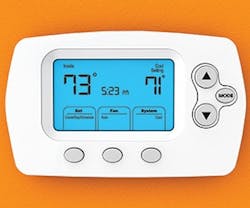Sophisticated controls can be a great way to boost the energy efficiency of your HVAC system, but if they’re not installed properly or used correctly, you may end up wasting energy without realizing it.
Issues with building controls are frequently the result of human error, explains Kevin Callahan, product owner for Alerton, a Honeywell business that specializes in building automation systems. Scheduling and setpoints are two of the biggest opportunities for mistakes. For example, an FM might override the allowed temperature range in response to an occupant complaint about a space that’s too hot, only to forget to restore the original setpoint later and waste cooling energy in the meantime.
Are your HVAC controls doing their job? Consider these tips to ensure they’re still working as intended.
1) Look for Overrides
If all of your controls appear to be functional – an important first step that control software can help confirm – your next move should be to review the settings for temperature and operational schedules to see if an adjustment has occurred. Nearly all control packages track user activity within the software, Callahan says. If every member of your team has their own unique user ID and password, it should be easy to track down the source of the override.
“You can see whether the setpoint was changed by a certain person. Some products even have a feature that forces the operator to put in a comment as to why they changed something in order to complete the override,” explains Callahan. “The comment should be a justification such as ‘This was changed by request of the occupant’ or ‘This setting was changed for testing purposes.’ Then you have an audit trail to explain why things were changed. If someone just types gibberish in the comment field, you can go back to that person for an explanation.”
You can also designate specific privileges and capabilities for different users; for example, giving the whole team the ability to see control settings and consumption data, but only allowing a handful of trusted colleagues to change the settings.
2) Program for Problems
If the issue doesn’t lie with the controls themselves or the people operating them, look for faults elsewhere in the process.
“Building management systems can be programmed during commissioning to say that if you run an air conditioning unit at 100% cooling for a specific period of time, such as 15 minutes, the discharge temperature should be 53 degrees F.,” Callahan explains.
“Now, every time I run that air conditioning unit for at least 15 minutes, I expect the discharge temperature to be 53 degrees,” Callahan adds. “If it’s 60, that tells me something is not right and the building operator should go check that unit. Write programs to look for expected behavior, and then if that expected behavior doesn’t happen, the system can signal the operator of a pending issue.”
3) Check End Devices
Over time, wear and tear on moving parts can stop equipment and controls from communicating properly, Callahan adds.
“The linkage on a damper actuator could loosen over time from vibration or not being tightened enough. Eventually, the linkage between the damper and the actuator loosens so much that the actuator is moving but the damper isn’t,” says Callahan. “That’s going to cause the system to work harder than it should, resulting in occupant discomfort and wasted energy.”
Janelle Penny [email protected] is senior editor of BUILDINGS.
About the Author
Janelle Penny
Editor-in-Chief at BUILDINGS
Janelle Penny has been with BUILDINGS since 2010. She is a two-time FOLIO: Eddie award winner who aims to deliver practical, actionable content for building owners and facilities professionals.

